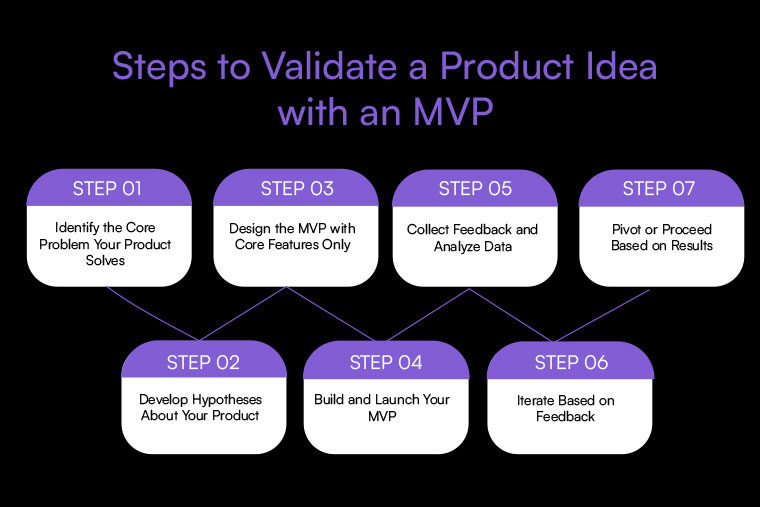Introduction
Launching a new product can be one of the most exciting yet daunting experiences for entrepreneurs and businesses alike. The excitement of creating something innovative is often matched by the fear of investing significant time, effort, and resources into an idea that may fail in the market. To mitigate this risk, one of the most effective strategies is validating your product idea before fully committing to large-scale development. The best way to do this is by creating a Minimum Viable Product (MVP).
An MVP is a stripped-down version of your product that includes only the essential features necessary to solve a core problem for your target audience. The idea is to release this simplified product to the market, gather user feedback, and validate whether your assumptions hold true before fully developing your product.
In this blog, we will take you through the entire process of validating a product idea using an MVP, from defining the problem and hypotheses to launching, collecting feedback, iterating, and ultimately deciding whether to pivot or proceed. By following these steps, you can significantly reduce the risk of your product idea failing and ensure that you build a solution your customers actually want.
Why Validate a Product Idea with an MVP?

Validating your product idea with an MVP is crucial for several reasons. Here are the top benefits of using this approach:
- Minimized Risk: An MVP allows you to test your product with a smaller investment in both time and money. By validating your assumptions early on, you can ensure that your product meets a real need before scaling.
- Cost Efficiency: Rather than spending months or years developing a full product, an MVP lets you develop and release a basic version quickly. This helps save costs by allowing you to focus only on essential features.
- Quick Market Feedback: Building an MVP means getting your product into users’ hands as soon as possible. This provides immediate, actionable feedback that you can use to improve the product.
- Learning About User Needs: By validating your idea with real users, you can gain insights into what your target audience actually wants and needs, which will guide you in building a more successful final product.
- Faster Time to Market: MVPs allow you to test and refine your product faster, which means you can bring it to market quicker than if you had developed a more feature-complete version.
- Better Decision Making: With insights from real users, you can make data-driven decisions about your product’s direction, features, and overall viability.
Steps to Validate a Product Idea with an MVP

Step 1: Identify the Core Problem Your Product Solves
Before jumping into the development of your MVP, it's essential to clearly identify the problem your product aims to solve. This is the foundation of your MVP and will guide everything from feature selection to marketing.
Key Questions to Ask:
- What specific problem are you trying to solve?
- Who is your target audience (age, location, profession, etc.)?
- How does your product provide a unique solution that is better than existing alternatives?
For example, if you're building an app to help people track their fitness progress, the core problem you're solving might be that people struggle to stay motivated without clear, measurable results. Your MVP might focus on tracking workouts and providing basic feedback to keep users engaged.
Step 2: Develop Hypotheses About Your Product
Once you've identified the problem, develop clear hypotheses about how your product will solve it. These hypotheses will guide your MVP development and set measurable goals for validation.
For instance, if you're developing a task management app for remote teams, one of your hypotheses could be:
- Hypothesis: “Remote teams will find a productivity boost using an app that allows them to easily assign and track tasks in one place.”
These hypotheses should be testable and measurable. They will determine the core features of your MVP that will help you validate whether your assumptions are correct.
Step 3: Design the MVP with Core Features Only
With your problem defined and hypotheses in hand, it's time to design your MVP. The key here is to focus only on the essential features that will allow you to test your hypotheses.
Best Practices for MVP Design:
- Identify the core features that solve the core problem. If your product is a task manager, features like task creation, assignment, and due date tracking should be included.
- Keep it simple: Avoid adding features that are not essential to solving the problem you’ve defined. More features may complicate the user experience and divert attention from the critical functionality.
- User-centric design: Even if your MVP is basic, ensure it’s user-friendly and intuitive. The goal is to validate your idea, and a poor user experience could skew feedback.
For example, if you're building a basic budgeting tool, your MVP might only include functions like income entry, expense tracking, and basic reporting, leaving out advanced features like investment tracking or financial advice.
Step 4: Build and Launch Your MVP
Now it’s time to build your MVP and get it into the hands of your target audience as quickly as possible. This is where the rubber meets the road—testing your assumptions in the real world.
There are various ways to launch your MVP:
- Beta Testing: You can release the MVP to a small group of early adopters who can provide feedback based on real-world use.
- Landing Pages: For digital products, create a landing page showcasing the MVP’s key features and offering an opportunity to sign up for early access or beta testing.
- Social Media: Promote your MVP via social media channels or online communities where your target audience is active to gather more users for testing.
Step 5: Collect Feedback and Analyze Data
Collecting feedback is one of the most important steps in the MVP process. The data you collect will give you insights into whether your MVP solves the problem you aimed to address, and how you can improve it.
Ways to Collect Feedback:
- Surveys and Interviews: Ask users to complete surveys or conduct interviews to understand their experience with your MVP.
- Usability Testing: Observe how users interact with the MVP. Are they using the features as intended? Where are they getting stuck?
- Analytics: Use tools like Google Analytics, Mixpanel, or Hotjar to track user behavior, such as how many users are signing up, how long they’re using the app, and what actions they are taking.
Key Metrics to Track:
- Engagement Rate: How often do users interact with the key features of your product?
- Conversion Rate: How many users take the desired actions (e.g., sign-up, purchase, etc.)?
- Retention Rate: How many users return after their first experience with your MVP?
- Customer Feedback: Direct insights into what users like or dislike about your MVP.
Step 6: Iterate Based on Feedback
The MVP process is iterative. Once you’ve collected feedback, use it to refine your product. This can include tweaking features, improving usability, or even removing functions that users didn’t find useful.
For example, if users found the task creation feature difficult to navigate in your project management app, consider simplifying the interface or providing clearer instructions.
Step 7: Pivot or Proceed Based on Results
After analyzing the data, it’s time to decide whether to pivot or proceed. Based on user feedback, you may find that the product doesn’t fully address the problem or that the market demand isn’t as strong as you thought. In this case, pivoting—changing the direction of your product—may be necessary.
Alternatively, if the MVP shows positive engagement, high retention, and good user feedback, you can proceed to develop a more polished, feature-rich version of your product.
Best Practices for Validating a Product Idea with an MVP

- Target the Right Audience: Ensure you’re testing with the right users—those who will benefit most from your product and fit your target demographic.
- Test Early and Often: Don’t wait until you have a perfect product. Start testing as soon as you have a functional MVP and continue to gather feedback regularly.
- Keep it Focused: Limit the features in your MVP to just what’s necessary to test your core hypothesis.
- Be Open to Feedback: Be ready to make changes based on what users tell you. Don’t be attached to features that aren’t working or resonating.
- Be Ready to Pivot: The MVP process is about learning, so don’t be afraid to change direction based on what the data tells you.
Conclusion

Validating a product idea with an MVP is one of the most effective ways to reduce risk, save resources, and ensure that your product addresses real market needs. By focusing on core features, testing early with real users, and iterating based on feedback, you can build a product that truly resonates with your target audience. The MVP process is not just about building a product; it’s about learning, adapting, and improving based on real-world insights.
At Cabot Technology Solutions, we specialize in helping businesses develop innovative solutions, including MVPs for startups and established companies alike. Our expert team ensures that your MVP not only tests your core ideas but is also scalable, secure, and user-friendly, giving you the confidence to proceed with full-scale development or pivot as needed. Whether you’re in the healthcare, tech, or any other industry, we can help you bring your MVP to life efficiently and effectively, turning your product ideas into market-ready solutions.

